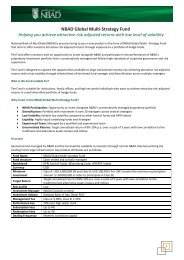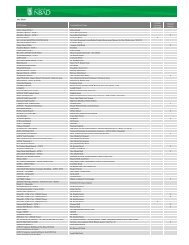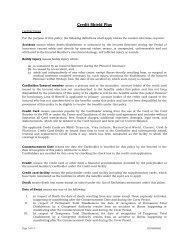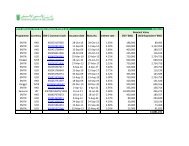English Version - National Bank of Abu Dhabi
English Version - National Bank of Abu Dhabi
English Version - National Bank of Abu Dhabi
Create successful ePaper yourself
Turn your PDF publications into a flip-book with our unique Google optimized e-Paper software.
Notes to the consolidated financial statements<br />
Notes to the consolidated financial statements<br />
5 Use <strong>of</strong> estimates and judgements (continued)<br />
5 Use <strong>of</strong> estimates and judgements<br />
(i)<br />
In the process <strong>of</strong> applying the Group’s accounting policies, management has made the following estimates and judgements,<br />
which have the most significant effect on the amounts recognised in the consolidated financial statements.<br />
Key sources <strong>of</strong> estimation uncertainty<br />
Impairment charge on loans and advances and investments<br />
Impairment losses are evaluated as described in accounting policy 3(b) (ix).<br />
The Group evaluates impairment on loans and advances and investments on an ongoing basis and a comprehensive<br />
review on a quarterly basis to assess whether an impairment charge should be recognised in the consolidated income<br />
statement. In particular, considerable judgement by management is required in the estimation <strong>of</strong> the amount and timing <strong>of</strong><br />
future cash flows when determining the level <strong>of</strong> impairment charge required. In estimating these cash flows, management<br />
makes judgements about counterparty’s financial situation and other means <strong>of</strong> settlement and the net realisable value <strong>of</strong><br />
any underlying collateral. Such estimates are based on assumptions about several factors involving varying degrees <strong>of</strong><br />
judgement and uncertainty, and actual results may differ resulting in future changes to such impairment charges.<br />
(ii) Collective impairment charge on loans and advances<br />
In addition to specific impairment charge against individually impaired assets, the Group also maintains a collective<br />
impairment allowance against portfolios <strong>of</strong> loans and advances with similar economic characteristics which have not<br />
been specifically identified as impaired. In assessing the need for collective impairment charge, management considers<br />
concentrations, credit quality, portfolio size and economic factors. In order to estimate the required allowance, assumptions<br />
are made to define the way inherent losses are modelled and to determine the required input parameters, based on<br />
historical and current economic conditions.<br />
(iii) Contingent liability arising from litigations<br />
Due to the nature <strong>of</strong> its operations, the Group may be involved in litigations arising in the ordinary course <strong>of</strong> business.<br />
Provision for contingent liabilities arising from litigations is based on the probability <strong>of</strong> outflow <strong>of</strong> economic resources<br />
and reliability <strong>of</strong> estimating such outflow. Such matters are subject to many uncertainties and the outcome <strong>of</strong> individual<br />
matters is not predictable with assurance.<br />
(iv) Share option scheme<br />
The fair value <strong>of</strong> the share option scheme is determined using Black- Scholes. The model inputs comprise share price,<br />
exercise price, share price volatility, contractual life <strong>of</strong> the option, dividend yield and risk-free interest rate.<br />
Critical accounting judgements in applying the Group’s accounting policies include:<br />
(a) Financial asset and liability classification<br />
The Group’s accounting policies provide scope for financial assets and liabilities to be designated on inception into<br />
different accounting categories in certain circumstances:<br />
In classifying financial assets as “fair value through pr<strong>of</strong>it or loss”, “held for trading”, “held-to-maturity” or “available for<br />
sale”, the Group has determined it meets the description as set out in accounting policy 3(b) (iii, iv and v) respectively.<br />
(b) Qualifying hedge relationships<br />
In designating financial instruments as qualifying hedge relationships, the Group has determined that it expects the hedge<br />
to be highly effective over the life <strong>of</strong> the hedging relationship.<br />
(c) Valuation <strong>of</strong> financial instruments<br />
The Group’s accounting policy on fair value measurements is discussed in accounting policy 3(b) (viii) and note 6.<br />
6 Financial assets and liabilities<br />
Fair value <strong>of</strong> financial instruments<br />
All financial assets and liabilities are measured at amortised cost except for derivatives, trading and non-trading investments<br />
which are measured at fair value by reference to published price quotations in an active market or from prices quoted by<br />
counterparties or through use <strong>of</strong> valuation techniques such as discounted cash flow method.<br />
Fair value is the amount for which an asset could be exchanged, or a liability settled, between knowledgeable willing parties<br />
in an arm’s length transaction. Consequently, differences can arise between book values and the fair value estimates.<br />
Underlying the definition <strong>of</strong> fair value is the presumption that the Group is a going concern without any intention or<br />
requirement to materially curtail the scale <strong>of</strong> its operation or to undertake a transaction on adverse terms.<br />
The Group measures fair values using the following fair value hierarchy that reflects the significance <strong>of</strong> the inputs used in<br />
making the measurements:<br />
• Level 1: Quoted market price (unadjusted) in active market for an identical instrument.<br />
• Level 2: Valuation techniques based on observable inputs, either directly (i.e., as prices) or indirectly (i.e., derived from<br />
prices). This category includes instruments valued using: quoted market prices in active markets for similar<br />
instruments; or other valuation techniques where all significant inputs are directly or indirectly observable<br />
from market data.<br />
• Level 3: Valuation techniques using unobservable inputs. This category includes all instruments where the valuation<br />
technique includes input not based on observable data and the unobservable input have a significant impact<br />
on the instrument’s valuation.<br />
Valuation techniques include net present value and discounted cash flow models, comparison to similar instruments for<br />
which market observable prices exist, Black-Scholes and other valuation models. Assumptions and inputs used in valuation<br />
techniques include risk-free and benchmark interest rates, credit spreads and other inputs used in estimating discount rates,<br />
bond and equity prices, foreign currency exchange rates, equity and equity index prices and correlations. The objective<br />
<strong>of</strong> valuation techniques is to arrive at a fair value determination that reflects the price <strong>of</strong> the financial instrument at the<br />
reporting date that would have been determined by market participants acting at arm’s length.<br />
The fair values <strong>of</strong> due from banks, due to banks, repurchase agreements and customers’ deposits which are predominantly<br />
short term in tenure and issued at market rates, are considered to reasonably approximate their book value.<br />
The Group estimates that the fair value <strong>of</strong> its loans and advances portfolio is not materially different from its book value since<br />
majority <strong>of</strong> loans and advances carry floating market rates <strong>of</strong> interest and are frequently re-priced. For loans considered<br />
impaired, expected cash flows, including anticipated realisation <strong>of</strong> collateral, were discounted using an appropriate rate<br />
and considering the time <strong>of</strong> collection, the net result <strong>of</strong> which is not materially different from the carrying value.<br />
71
















